Labs use tremendous volumes of exhaust air to flush out potentially hazardous air. This air must be replaced by fresh outside air that is heated in winter or cooled in summer to keep spaces comfortable. This uses a tremendous amount of energy, often 4-6 times more energy per square foot than a typical office building.
Key Energy-Saving Opportunities
1. Manage Lab Air Changes
Many older labs with low fume hood counts operate at 10 Air Changes per Hour (ACH) or above, 24 hours a day. This is the largest driver of energy costs in most labs. New technologies, combined with new national standards for lab ventilation, allow labs to substantially reduce ventilation rates. To quantify the energy savings related to air flow reduction and rebalancing, leverage the Sponsors of Mass Save’s technical assistance.Learn More
2. Reduce Fume Hood Exhaust
Fume hoods are often the drivers of lab ventilation rates. Measures that reduce fume hood exhaust—like sash monitoring programs, sash positioners or modified sash systems, proximity sensors, reduced face velocity requirements, high-efficiency hoods, and more—can produce substantial savings. To quantify the energy savings associated with rebalancing and reducing fume hood use, leverage the Sponsors of Mass Save’s technical assistance.Learn More
3. Heating & Cooling Equipment Upgrades
Heating and cooling can be large expenses for a laboratory. By properly maintaining equipment or upgrading to high-efficiency systems, your lab can enjoy long-term reduced energy usage, decrease equipment maintenance time, reduce greenhouse gas emissions, and create a comfortable environment.Learn More
4. Lab Grade Equipment Upgrades
The Sponsors of Mass Save offer rebates on ENERGY STAR® certified cold storage products. For participating commercial customers, this means more affordable, energy- efficient models and savings on operating costs.

Case Study: Beth Israel Deaconess Medical Center
This teaching hospital of Harvard Medical School improved safety and optimized the operation of their laboratories with demand control ventilation upgrades.
Not Sure Where To Start?
If you’re looking for advice on how to save energy, the Sponsors of Mass Save offer energy assessments and guidance to support efficiency projects from start to finish.
Learn More